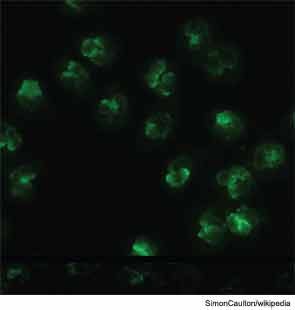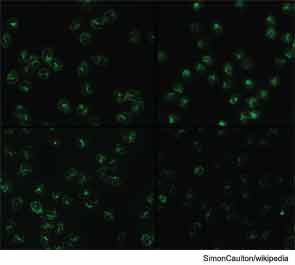

SNOWMASS, COLO.—Testing for antibodies to neutrophil cytoplasmic antigens (ANCA) can be clinically useful, but test results sometimes require further investigation, according to Ulrich Specks, MD, professor of medicine at the Mayo Clinic College of Medicine and chair of the division of pulmonary and critical care medicine at the Mayo Clinic in Rochester, Minn. “There is no perfect ANCA test. That is one truth that everyone needs to walk away with,” Dr. Specks said during a session titled, “Clinical Utility of ANCA Testing,” here at the ACR Winter Rheumatology Symposium, held January 26–February 1, 2013. “Not even a perfect test could give you a definitive answer to all clinical questions.”
Various testing methods are used to identify types of ANCA with different specificities. Immunofluorescence microscopy is used to identify two major categories of ANCA—with cytoplasmic staining (C-ANCA) or with artifactual perinuclear staining (P-ANCA)—and these can have specificity for proteinase 3 (PR3) and myeloperoxidase (MPO). The most frequently used tests for antigen-specific detection are enzyme-linked immunosorbent assay (ELISA) methods, Dr. Specks said. These include direct ELISA and capture ELISA. With direct ELISA, there is always a tradeoff of analytical sensitivity versus specificity, he added, saying this is especially true with PR3, which is difficult to purify. Capture ELISA, on the other hand, is designed to get around the issue of specificity, but has the potential of a false negative because of competition for antigens in the target assay.
Multiplex microsphere technology allows the detection of different antibodies against different target antigens simultaneously. With these bead-based multiplex assays, specific antibodies to different antigens are detected in a single tube, generating separate results for each antigen specificity. However, Dr. Specks noted, charges are for each separate test so it can be expensive.
Topics of controversy surrounding ANCA testing today are whether both methodologies are needed—immunofluorescence and antigen-specific testing—and whether the ANCA type (PR3 or MPO) really matters at the end of the day. Another area of controversy is the value of serial ANCA testing and whether the results have implications for patient treatment. “This is where opinions diverge dramatically,” Dr. Specks said.
Troubleshooting Test Results
Often, ANCA test results can generate additional questions, said Dr. Specks, who is frequently asked to consult on “equivocal” or “inconsistent” ANCA test results and their clinical interpretation. Only C-ANCA/PR3-ANCA and P-ANCA/MPO-ANCA pairs have positive predictive value for small vessel vasculitis, so when test results appear mismatched, further investigation is advised.
Case 1: For example, an 84-year-old woman presented with nonspecific interstitial infiltrates. Her ANCA test results were negative for C-ANCA and P-ANCA but positive for PR3, and MPO was a negative mismatch. Clinically, the positive PR3 result was a low pretest probability for granulomatosis with polyangiitis (Wegener’s), which warranted further investigation. After looking into the laboratory—which had changed its assay as a result of regular quality testing—the next step was to use a backup methodology to troubleshoot the test result. A high-sensitivity antigen-specific assay—direct ELISA—was used at the time, but Dr. Specks noted that he would use the microsphere assay today. Follow-up testing with immunofluorescence indicated the absence of PR3 antibodies. This case demonstrates a methodologically false-positive test result that should be ignored in this clinical setting, Dr. Specks added.
Case 2: In another example, a 55-year-old man presented with destructive nasal disease and hearing problems. He had no systemic symptoms and no other evidence of vasculitis. Testing came back with a mismatch: positive for P-ANCA and PR3-ANCA but negative for MPO-ANCA. In this case, the patient history indicated cocaine-induced midline destructive lesions (CIMDL), which mimics granulomatosis with polyangiitis (Wegener’s) with more severe local destruction, fewer systemic symptoms, and no other organs being involved. CIMDL is also associated with positive P-ANCA and negative MPO-ANCA tests, and possibly positive PR3-ANCA tests.
“Unfortunately the cocaine story over the last few years has gotten more complex with levamisole as a contaminant,” Dr. Specks said. High-titer MPO-ANCA results are associated with levamisole use.
The conclusion for the diagnosis of ANCA-associated vasculitis, Dr. Specks said, is that “single-modality testing will get you into trouble” because it can provide misleading results. If anything other than matching pairs are determined, troubleshooting is necessary.
Serial Testing to Predict Relapses
In addition to being a diagnostic tool for vasculitis, ANCA testing may be useful for predicting relapses and guiding treatment. There is some evidence to suggest that ANCA levels correlate with disease activity. It probably doesn’t matter which method is used for serial ANCA testing, as long as the same test is used consistently for the same patient, Dr. Specks said.
Dr. Specks and his team conducted a study of serial ANCA testing to determine whether PR3-ANCA decreases are associated with a shorter time to sustained remission, and whether PR3-ANCA increases predict relapses.1 They collected samples every three months and analyzed all samples using capture ELISA methods. The researchers found that patients who had a decrease in PR3-ANCA levels had faster time to complete sustained remission than those who didn’t have a decrease during treatment, although the result did not reach statistical significance, Dr. Specks said.
More recently, a literature review to explore whether ANCA values are predictive of future relapse indicated that, among patients with ANCA-associated vasculitis, a rise in or persistence of ANCA during remission is modestly predictive of future disease relapse.2 The problem with the studies that were analyzed in this review, Dr. Specks said, is that serum samples were collected at different time intervals, different analytical methods were used, and the researchers defined remission and flares differently.
The modest association between ANCA measures and potential relapse “is true for patients treated with conventional therapy,” Dr. Specks said. “The treatment decision should never be made based on ANCA test results alone. We all have seen patients who have been maintained on immunosuppressive therapy because the ANCA test remained positive. But the thing we need to get out of our minds is that a positive ANCA test means the patient is not in remission.”
Implications for Treatment
Ultimately, the ANCA type does matter from a clinical perspective. To date, serial data that are available for ANCA test results are mostly PR3 versus MPO. Research has shown that PR3-ANCA conveys worse mortality, higher relapse rates, and more rapid renal function loss.
In research, when patients are separated by ANCA type at baseline, there is no difference for treatment among MPO-positive patients in comparative studies. However, PR3-positive patients achieve superiority with rituximab, Dr. Specks said, and different responses have been seen with rituximab versus cyclophosphamide treatment. Clinically, a PR3-ANCA patient may respond with recovering renal function, Dr. Specks said, whereas an MPO patient may not respond in remission with the same treatment regimen.
“With serial testing, once you know the ANCA in your patient, you might limit yourself to a certain assay,” Dr. Specks said. “The switch from MPO to PR3 almost never happens.” The diagnostic utility of ANCA testing depends on the methodology and clinical setting, and it is important to note when predictive pairs are present. If there are mismatches or multiple positive antigens, Dr. Specks advised, “get your thinking cap on, discuss it, and keep an open mind to avoid going down the wrong path with your patient.”
Kimberly J. Retzlaff is a medical journalist based in Denver.
References
- Finkielman JD, Merkel PA, Schroeder D, et al. Antiproteinase 3 antineutrophil cytoplasmic antibodies and disease activity in Wegener granulomatosis. Ann Intern Med. 2007;147:611-619.
- Tomasson G, Grayson PC, Mahr AD, Lavalley M, Merkel PA. Value of ANCA measurements during remission to predict a relapse of ANCA-associated vasculitis—a meta-analysis. Rheumatology (Oxford). 2012;51:100-109.

